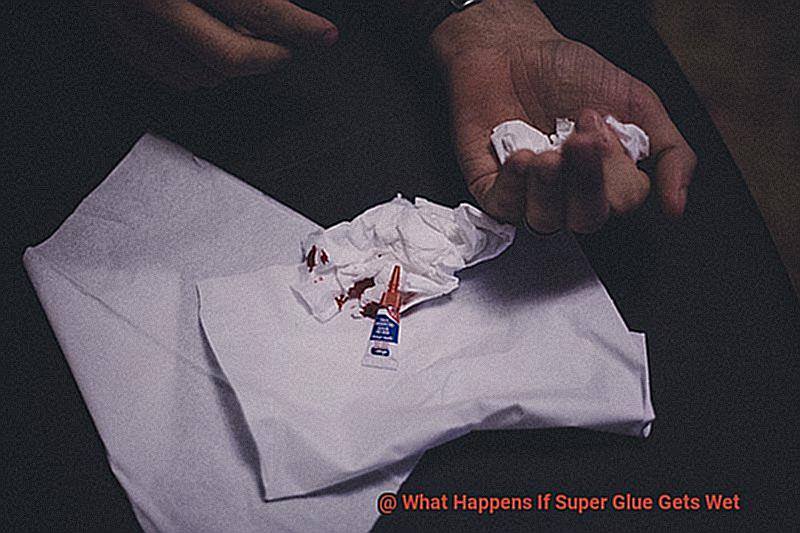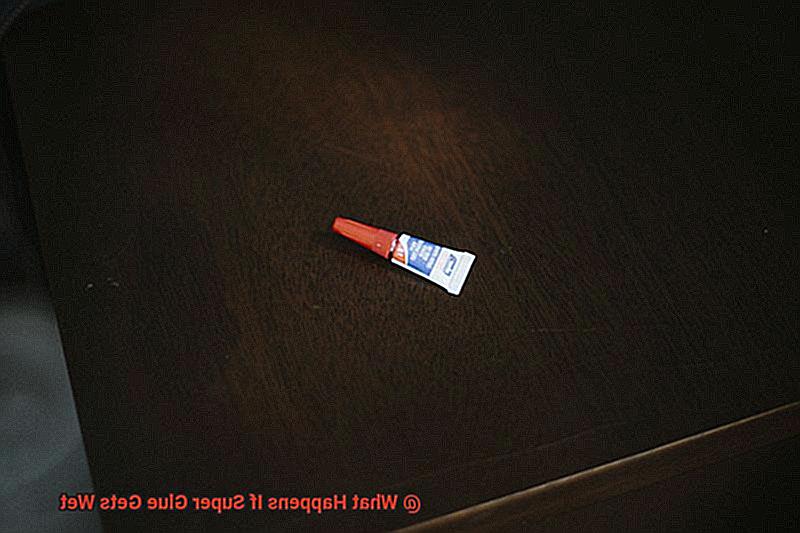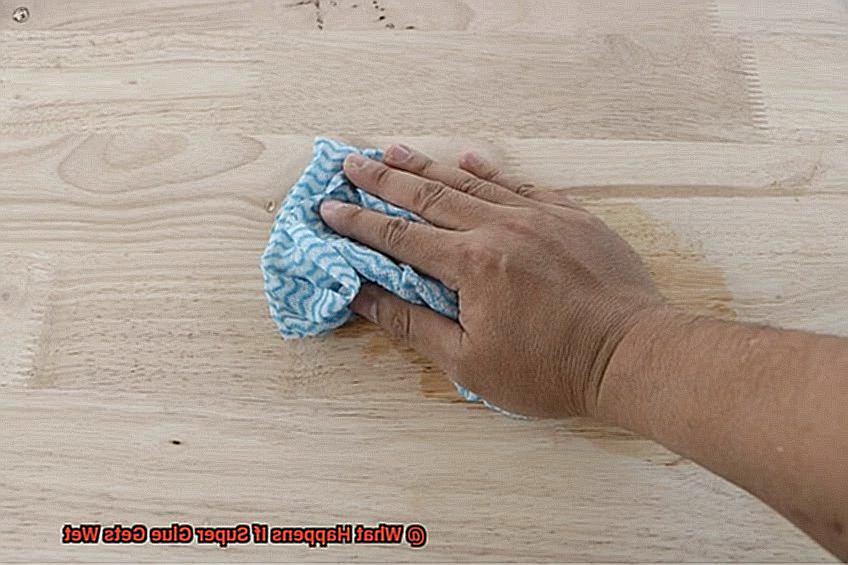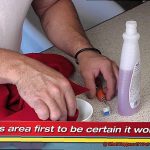We’ve all experienced the sheer magic of super glue – that miraculous adhesive capable of bonding just about anything.
But what happens when this mighty glue meets its arch-nemesis: water? Imagine this: you’ve painstakingly glued together your favorite porcelain vase, only for it to be drenched in a sudden downpour.
Today, we embark on a journey to uncover the thrilling truth behind super glue’s wet encounters.

Get ready for unexpected surprises and practical tips to conquer those accidental glue mishaps head-on.
What is Super Glue?
Contents
- 1 What is Super Glue?
- 2 How Does Super Glue Work?
- 3 What Happens When Super Glue Gets Wet?
- 4 Effects of Water on the Curing Process of Super Glue
- 5 Long-Term Effects of Water on Super Glue Bonds
- 6 Different Types of Super Glues and Their Water Resistance Capabilities
- 7 Preparing Surfaces for Bonding with Super Glue
- 8 Tips for Using Super Glue in Wet Conditions
- 9 Conclusion
Super glue, also known as cyanoacrylate adhesive, is an incredibly versatile and popular adhesive used for bonding various materials together. It was first discovered by Dr. Harry Coover in the 1940s while working on a project to develop clear plastic gun sights for the Allies during World War II. Originally intended as a heat-resistant polymer, Dr. Coover stumbled upon the adhesive properties of cyanoacrylate and thus super glue was born.
Super glue comes in small tubes or bottles and is a clear, liquid adhesive with a low viscosity, allowing it to flow easily and spread quickly on surfaces. Its main ingredient is cyanoacrylate, an acrylic resin that is attracted to moisture. This attraction triggers the curing process, leading to a strong bond. Super glue cures rapidly when exposed to moisture, making it ideal for quick repairs and emergency fixes.
However, it’s important to note that super glue is not suitable for all materials. It works best on non-porous surfaces like metal, plastic, glass, and ceramics, but may not bond well with porous materials like wood or fabric.
Once cured, super glue forms a tight bond that is resistant to heat, cold, chemicals, and most solvents. However, it can become brittle over time and may not withstand excessive force or tension.
Super glue is not only useful for its adhesive properties but can also be used as a filler or gap-filling agent. By applying multiple layers of the adhesive and allowing each layer to cure before adding another, it can be built up to fill gaps or holes.
Super glue is widely available in hardware stores, craft stores, and online. It is typically sold in small quantities due to its quick curing nature. To prolong its shelf life, it should be stored in a cool, dry place.
How Does Super Glue Work?
Today, we’re diving into the fascinating world of super glue, that mystical adhesive that seems to work wonders in a matter of seconds. Have you ever wondered how this superhero of adhesives manages to create such unbreakable bonds? Join me as we uncover the secrets behind the magic of super glue.
At the heart of super glue’s power lies cyanoacrylate, a special type of ester that possesses an extraordinary ability to polymerize rapidly. When applied to a surface, this incredible substance reacts with ambient moisture, triggering a chain reaction that forms long, interconnected chains of molecules. As these chains link together, they create a solid and durable bond that can withstand remarkable levels of stress and strain.
One of the most astonishing features of super glue is its lightning-fast curing process. Unlike traditional adhesives that require hours or even days to set, super glue springs into action within seconds. This rapid curing is made possible by the presence of water vapor in the air, which acts as a catalyst for the polymerization reaction. The water molecules speed up the bonding process, allowing the glue to reach its full strength in no time.
To ensure optimal bonding results, it’s crucial to prepare your surfaces properly before applying super glue. Any contaminants or moisture on the surfaces can hinder the bonding process and weaken the adhesive’s strength. Take a moment to clean and thoroughly dry both surfaces before bringing them together. This simple step will enhance the effectiveness and longevity of your bond.
Once super glue has set and formed its strong bond, it becomes resistant to water. The cured adhesive creates a protective barrier that shields the bonded surfaces from moisture penetration. This remarkable water resistance makes super glue an excellent choice for outdoor projects and items that may come into contact with liquids.
While super glue boasts impressive water resistance, prolonged exposure to water can still have a detrimental effect on its bond over time. Continuous contact with moisture can gradually degrade the adhesive, causing it to lose strength and flexibility. To preserve your bond’s integrity, avoid submerging items bonded with super glue in water or exposing them to excessive moisture for extended periods.
What Happens When Super Glue Gets Wet?
Super glue is a remarkable adhesive that forms unbreakable bonds in mere seconds. But what happens when it encounters the wet world? In this blog post, we will delve into the mysterious effects of water on super glue, providing expert tips on how to minimize its impact. So grab your favorite beverage and let’s embark on a journey into the enchanting realm of super glue.
Effects of Water on Super Glue:
- Weakening of Bond: When super glue gets wet, its adhesive properties can be compromised. The bond it creates may weaken or even break entirely, necessitating reapplication.
- Hazy Film Formation: Another captivating reaction occurs when water meets super glue – a white, hazy film appears on the glued surface. This film is a result of the interaction between water and the remnants of the glue. It can be unsightly and may require additional cleaning or polishing for removal.
Waterproof Super Glue:
Specialized Formulations: Not all super glues react in the same way to water. Some are specifically designed to be water-resistant or waterproof. These specialized formulations contain additional ingredients that help maintain adhesive strength even in wet conditions.
Tips to Minimize Water’s Impact:
- Dab Away Excess Moisture: If you accidentally expose wetness to drying super glue, gently dab away any excess moisture with a clean cloth or tissue. Avoid rubbing, as it may spread the glue further.
- Air Dry Naturally: Allow the damp area to air dry naturally. Avoid using heat or blow-drying methods, as they can exacerbate the damage caused by water.
Prevention is Key:
- Proper Storage: To prevent super glue from encountering moisture, store it in a cool and dry place. Ensure the container is tightly sealed when not in use to minimize air and moisture exposure.
- Waterproof Super Glue: If you anticipate using super glue in wet conditions or on surfaces that may come into contact with water, consider employing specialized waterproof super glue. These extraordinary glues are designed to withstand water exposure and maintain their adhesive strength, even when submerged or exposed to moisture.
Effects of Water on the Curing Process of Super Glue
In this captivating journey, we will unravel the mysterious effects of water on the curing process of super glue. Brace yourself as we explore the weakening bonds, hazy film formations, and discover expert tips to minimize water’s impact. So grab a beverage and embark on this enchanting adventure into the world of super glue.
The Curing Process:
Super glue, also known as cyanoacrylate adhesive, is renowned for its rapid-drying and strong adhesive properties. Its curing process occurs when the adhesive reacts with moisture or water vapor in the air, triggering polymerization and solidifying the bond between surfaces.
The Impact of Water:

Unfortunately, water can impede this delicate chemical reaction, compromising the overall strength of the adhesive. When exposed to water before fully curing, super glue may become tacky instead of hardening properly. This weakens the bond and may require additional drying time or reapplication.
Water Resistance:
Not all super glues are created equal when it comes to water resistance. Some formulations are specifically designed to withstand exposure to moisture, making them ideal for applications where encounters with water are likely.
Factors at Play:
Besides water, temperature and humidity also influence the effects of water on super glue curing. Higher temperatures and humidity levels accelerate cure time, while lower temperatures and drier conditions prolong it.
Mitigating Water’s Impact:
If water accidentally contacts uncured super glue, fear not. Gently blotting the wet area with a paper towel or cloth removes excess moisture. Avoid vigorous wiping to prevent spreading the uncured adhesive and damaging the bonded surfaces. After blotting, allow complete air drying, understanding that water can slow down the hardening process.
Long-Term Effects of Water on Super Glue Bonds
Today, we dive into the captivating realm of super glue and its complex relationship with water. Whether you’re a DIY enthusiast, a craft aficionado, or simply curious about the science behind bonding agents, this article will shed light on how water affects the strength and durability of super glue bonds over time.
The Battle Begins: Water vs. Super Glue Bonds:
Super glue, scientifically known as cyanoacrylate adhesive, is renowned for its exceptional bonding properties. However, when water enters the arena, it can interfere with the bonding process and weaken the strength of the bond. While a small amount of water may have little impact in the short term, prolonged exposure can gradually degrade the bond.
The Swelling Effect:
Picture this: water molecules infiltrating the glue, causing it to swell or soften. This swelling weakens the adhesive’s grip, compromising its adhesion capabilities and eventually leading to bond failure. Moisture acts as a catalyst for chemical reactions that break down the adhesive properties, hastening the degradation process.
Water-Resistant Wonders:
Not all super glues are created equal. Some formulations are designed to be water-resistant or even waterproof, providing superior performance in wet conditions. Before embarking on your project, check if your chosen glue boasts these fantastic qualities for extra peace of mind.
Factors at Play:
Remember that temperature, humidity levels, and surface types influence the long-term effects of water on super glue bonds. High humidity and extreme temperatures can exacerbate bond degradation. Also, certain surfaces may interact differently with water and glue, requiring special attention during bonding.
Discoloration Dilemma:
Have you ever noticed a hazy film or discoloration after exposing your glued surface to water? Fear not. In most cases, these aesthetic changes are harmless and do not affect the adhesive properties unless severe degradation occurs.
Tips to Counter the Aquatic Challenge:
To minimize the long-term effects of water on super glue bonds, it is wise to limit exposure to excessive moisture or avoid immersing glued surfaces in water whenever possible. However, accidents happen. If your bond gets wet and starts to weaken, thoroughly dry the affected area before considering reapplying fresh glue to reinforce the bond.
Beyond Super Glue:
In situations where water exposure is inevitable or frequent, exploring alternative adhesive options may prove more suitable for achieving long-lasting bonds. Investigate specialized waterproof adhesives that are specifically designed to excel in wet conditions.
Different Types of Super Glues and Their Water Resistance Capabilities
Different types of super glues offer varying degrees of water resistance capabilities. When it comes to adhesive strength and durability in wet conditions, not all super glues are created equal. It is important to understand the different types available in the market to make an informed decision based on your specific needs.
One common type of super glue is cyanoacrylate adhesive, known for its fast bonding and strong holding power. However, cyanoacrylate adhesives are not inherently water-resistant. Moisture can weaken or even completely break down the bond formed by cyanoacrylate adhesives when exposed to water. This means that if a project bonded with cyanoacrylate adhesive gets wet, the bond may fail.
To address this issue, some super glue manufacturers have developed specialized formulations that offer improved water resistance. These water-resistant super glues contain additives that protect against moisture, enabling the glue to maintain its strength even when exposed to water. Look for products labeled as “waterproof” or “water-resistant” for optimal performance in wet conditions.
Epoxy adhesives are another type of super glue that provides enhanced water resistance. These adhesives consist of two components: a resin and a hardener.
In addition to cyanoacrylate and epoxy adhesives, there are also specialized super glues designed for specific applications that require high levels of water resistance. These specialized super glues are formulated to provide optimal performance in bonding materials like metal or plastic, which often have different water resistance requirements.
While water-resistant super glues offer improved performance in moist environments, it is important to note that they may still have limitations. Excessive exposure to water or prolonged immersion can still compromise the bond over time. Follow the manufacturer’s instructions and consider the specific requirements of your project to choose the most suitable super glue for your needs.
Preparing Surfaces for Bonding with Super Glue
Properly preparing surfaces for bonding with super glue is the key to achieving a strong and durable bond. By following a few simple steps, you can ensure that your surfaces are ready to withstand the power of super glue.
First and foremost, cleanliness is crucial. Before applying super glue, thoroughly clean the surfaces you intend to bond. Use a mild detergent or rubbing alcohol to remove any dirt, dust, oil, or other contaminants. These impurities can interfere with the adhesive properties of the super glue and weaken the bond.
Next, if you’re working with smooth or non-porous materials like glass or plastic, sanding is your secret weapon. Gently sand the surfaces using fine-grit sandpaper in a circular motion. This creates a slightly roughened texture that allows the super glue to adhere better. But be cautious not to go overboard and damage the material.
If you’re bonding surfaces that previously had adhesive applied, it’s crucial to remove any remnants of the old adhesive. Use an adhesive remover or scraping tool to gently get rid of any traces of the old adhesive. Those leftovers can weaken the bond and leave you feeling stuck (pun intended).
Moisture is a big no-no when it comes to bonding with super glue. Take a moment to ensure that both surfaces are completely dry before applying the adhesive. Moisture can seriously mess with the bonding process, so give them a quick once-over with a clean cloth or paper towel.
When it’s time to apply the super glue, remember: less is more. Apply a thin layer of super glue to one of the surfaces being bonded. Avoid going overboard with the glue – too much can result in a messy application and potentially weaken the bond. A small amount is usually all you need for a strong and durable hold.
Tips for Using Super Glue in Wet Conditions
Using super glue, or cyanoacrylate adhesive, in wet conditions can be challenging because moisture can interfere with the bonding process. However, with the right tips and techniques, it is possible to ensure a successful bond even in wet conditions. Here are some detailed tips for using super glue in wet conditions:
Dry the Surfaces
Before applying super glue, it is crucial to ensure that the surfaces you want to bond are clean and dry. Use a clean cloth or paper towel to thoroughly wipe away any moisture or debris. This will help the glue adhere properly and create a strong bond. If necessary, you can also use a hairdryer on a low heat setting to dry the surfaces completely.
Consider Waterproof Super Glue
If you frequently need to use super glue in wet conditions, consider using a specialized waterproof super glue. These glues are specifically designed to withstand moisture and provide a stronger hold in damp environments. Look for products labeled as “waterproof” or “moisture-resistant” for optimal performance.
Apply Sparingly
When using super glue in wet conditions, it is important to apply it sparingly. Excessive amounts of glue can take longer to dry and may not bond as effectively. A thin layer of glue on both surfaces is sufficient for a strong bond. Press the surfaces together firmly for best results.
Hold Firmly
In wet conditions, the drying process of super glue can be slower. To ensure a secure bond, hold the glued surfaces together firmly for a few minutes. Consider using clamps or tape to hold them in place until the glue completely sets. This will help prevent any movement that could disrupt the bonding process.
Check Expiration Date
Super glue can lose its effectiveness over time when repeatedly exposed to moisture. Always check the expiration date on the product before using it in wet conditions. If the glue is expired, replace it with a fresh one for optimal bonding results.
Remember, even with these tips, super glue may not be as effective in wet conditions compared to dry ones. It is important to assess the specific requirements of your project and choose the appropriate adhesive accordingly.
Lastly, always work in a well-ventilated area when using super glue, regardless of whether it is in wet or dry conditions. The fumes emitted by the glue can be strong and potentially harmful if inhaled excessively.
quPqewog1sE” >
Also Read: Is Super Glue Waterproof? – Glue Things
Conclusion
When super glue gets wet, it undergoes a chemical reaction that can weaken its bond.
The moisture interferes with the glue’s ability to create a strong and durable connection. Instead of forming a solid and secure hold, the glue may become soft, gooey, or even dissolve completely.
This means that if you accidentally expose super glue to water or any other form of liquid, its adhesive properties will be compromised.






